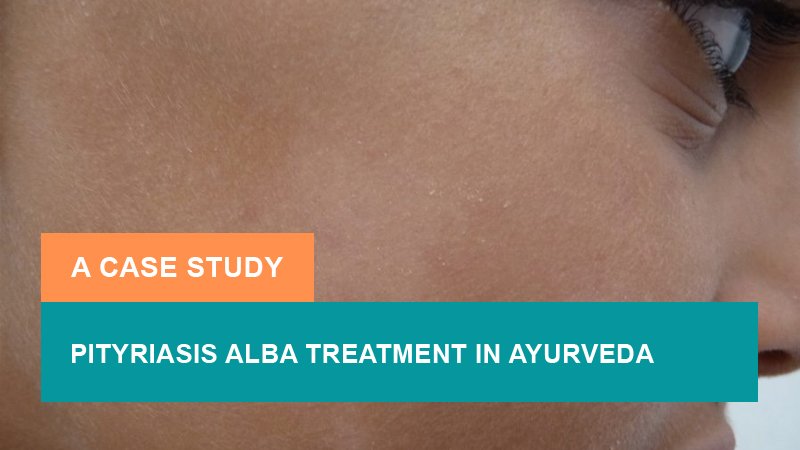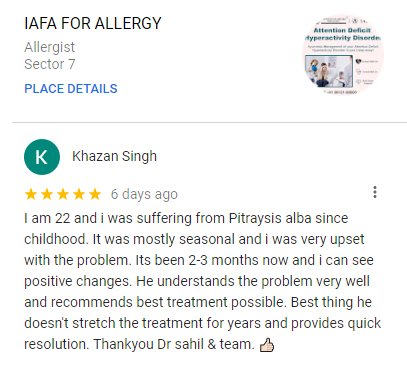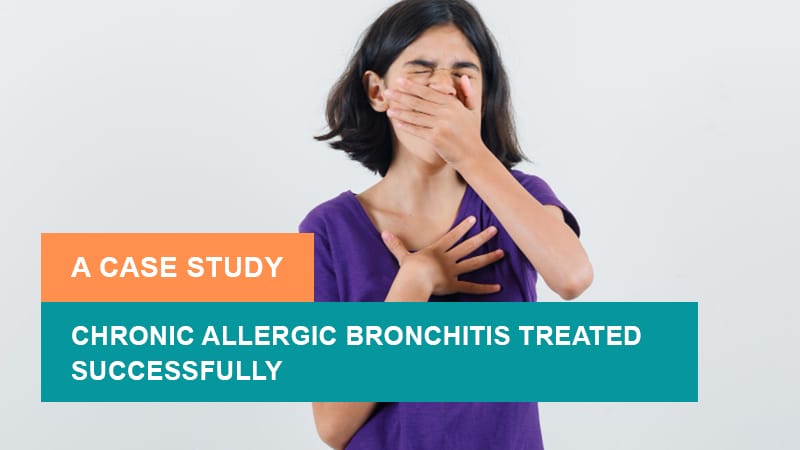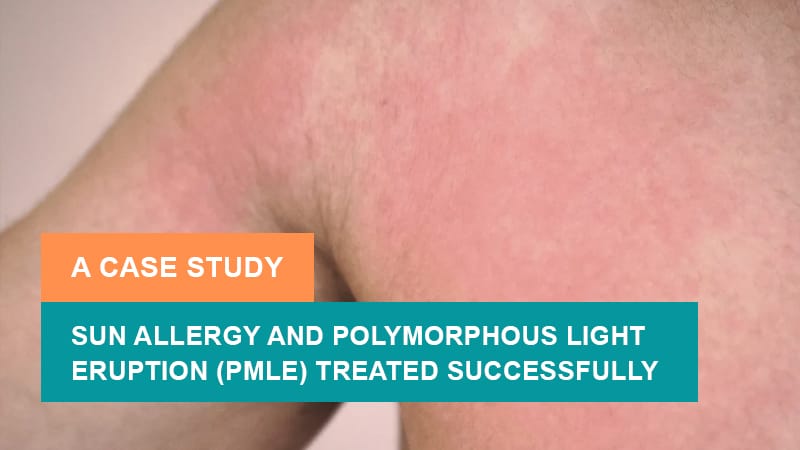As per Dermnet Nz prevalence of Pityriasis Alba is around 5%, mainly seen in children but sometimes can be observed in young and older people.
Pityriasis is a common skin condition where we can observe hypopigmented vesicles ranging from small to big on the skin. It is well-noticed in dark skin people. In some patients, it disappears over time but some need treatment.
But do you know that the allopathic treatment of Pityriasis Alba includes the use of corticosteroids which have long term side effects on the body? Even if they give symptomatic relief, they don’t cure the disease and prevent it from recurring. But, don’t worry we got you.
That’s why we are here proudly introducing and bringing awareness to ancient Ayurveda. Its herbs are a miracle leaving you with the desired outcome and no side effects.
We know you might have already heard about IAFA® founded by Dr Sahil Gupta, because of his successful treatment known not only over India but also in the US, Canada, and Australia. At IAFA® Dr Sahil Gupta who is an Ayurvedic allergy specialist treats all kinds of skin allergies, nasal allergies, food allergies and more. Don’t even give a second thought to booking a consultation with Dr Gupta if you are suffering from any kind of allergies and are fed up with the alternative treatments.
This case is about a 23-year-old female who has been suffering from Pityriasis Alba and has been successfully cured at IAFA® by Dr Sahil Gupta. We are happy to bring you another case study which is full of knowledge about our ancient Ayurveda and also the review of our healthy and happy patients.
Abstract
As we have already said Pityriasis Alba is a common type of low-grade eczema which is more prevalent in children than in younger and older people. But, there are some rare cases that we can observe in younger people too. The exact causes of this condition are unknown, but there is a relationship between this condition and the exposure of patients to UV radiation, poor skin hygiene, inappropriate bathing, and fungus (Yeast Malassezia). The symptoms can be seen with the naked eye, there are hypopigmented vesicles which are sometimes white and sometimes red. These vesicles are of different sizes ranging from small to large, minimum or no itching can be seen, and dry scaly skin is common in winters. The patient has been successfully treated at IAFA® with herbs and an ayurvedic diet recommended by Dr Sahil Gupta.
Keywords: Pityriasis Alba, Ayurvedic treatment of Pityriasis Alba, Herbs for Pityriasis Alba, Alternative treatment of Pityriasis Alba, Ayurvedic diet for Pityriasis Alba, Mandala Kusta, Skin Allergies, Successful treatment of Pityriasis Alba.
Case Study
- Patient Name: Kanishka
- Age: 23 years old
- Gender: Female
- UID: 6852
- Location: Noida (India)
- Date of Admission: 22/1/2022
Introduction
The hypopigmented lesions range from 0.5 to 5 cm in diameter and is rare or white, commonly called Pityriasis Alba. This is a common skin condition in children but a rare condition in younger and older people. Patients feel less or no itching, white or red vesicles in the skin, and dry scaly skin, especially in winters. There is no exact cause for this condition, but research shows that some poor skin hygienic habits by the patient and low levels of trace elements especially copper in the body may be of an etiology. The patient is advised to follow a good skin routine along with some herbal medicine in Ayurveda which promises a permanent cure for the condition and patients need not worry about any side effects and reoccurring of the disease. Because Ayurveda completely focuses on the elimination of the root cause of the disease, the herbs are aligned with nature so they are with zero side effects.
Symptoms
The patient has told IAFA® that she has been suffering from this condition for 11-13 years. The following symptoms have been experienced by the patient:
- Round or oval-shaped lesions on her cheeks.
- Itching is minimal.
- Vesicles are hypopigmented.
- Lesions are white and small.
- The patient also worried about her visual appearance.
Causes
The exact cause of this condition is still not known. But researchers are conducting trials to find the etiology of this condition. But, there are relationships with the following:
- Low serum or other trace elements in the body.
- Excessive or inadequate bathing.
- Exposure to ultraviolet radiation.
- Poor skin hygiene.
- Fungal infections such as Yeast Malassezia.
Diagnosis
As per the clinical history of the patient and her visual symptoms, Dr Sahil Gupta finally diagnosed the condition as Mandala Kusta (Pityriasis Alba).
Treatment Plan
Dr. Sahil Gupta at IAFA® has treated the patient with both external and internal treatments. The treatment includes the following herbs.
External Treatment:
1. IAFA 333 Cream:
It is a 100% natural moisturizing cream that has been prepared under the direction of IAFA®.
Indications: It is used to treat dry skin and helps in retaining the moisture of the skin. It can be used in the treatment of eczema and psoriasis.
Dosage: Apply 3-5 gms of IAFA 333 Cream on the affected area and results can be seen within a few days of usage.
Key ingredients: The key ingredients have antibacterial, anti-inflammatory, anti-itching and antibiotic properties. These herbs are fortified with coconut oil which helps in soothing the skin and retaining moisture.
| S.No. | Key ingredients |
| 1. | Pongamia Glabra |
| 2. | Wrightia Tinctoria |
| 3. | Albizia Lebbeck |
| 4. | Azadirachta indica |
Internal Treatment:
2. Aahar Amrutham Ras (IAFA Swaras Chikitsa):
- Ancient and safest herb in ayurvedic medicine.
- As per Ayurveda Charaka, Swaras bypass the digestive system and enter directly into the bloodstream.
- It shows high efficiency in the liquid form and is easily absorbed.
- The aroma and benefits of the herb don’t change even if used alone or combined with others.
- It helps in the absorption of herbs easily.
Key Ingredients
| Herbs | Quantity |
| Chotti Dudhi (Euphoriba Thymifolia) | 2ml |
| Shrifal (Aegle Marmelos) | 2ml |
| Bhoomi Amla (Phyllanthus Niruri) | 2ml |
| Punarnava (Boerhavia Diffusa) | 2ml |
Dosage: 30ml should be taken along with water before meals once a day.
Benefits: These herbs help in the cure of ailments and enhance the immunization of the body.
3. Anthram Mithram Gulika:
It is a unique Ayurvedic parpati preparation that is prepared to disintegrate in the duodenum and helps in the improvement of digestion of the food. It is highly potent and helps in the maintenance of the absorption surface of the gut.
Dosage: 400mg tablet twice a day after meal with lukewarm water.
Key Ingredients:
| Herbs | Quantity |
| Praval Panchamrit Ras | 50mg |
| Piyush Villa Ras | 50mg |
| Mukta Panchamrit Ras | 25mg |
| Kutuzghan Vati | 50mg |
| Giloy Satv | 50mg |
| Godanti Bhasam | 75mg |
| Swarnmakshik Bhasam | 25mg |
| Mukta Shukti Pishti | 25mg |
| Vijay Parpati | 5mg |
| Suvarna Parpati | 25mg |
| Panchamrit Parpati | 20mg |
4. Aahar Amrutham Gulika:
This is an unique Ayurvedic preparation that is useful for the maintenance of good intestinal balance. This is useful for the treatment of various diseases due to food allergies and food indigestion. It is prepared under the direction of IAFA®, used for the alleviation of various gastrointestinal disorders.
Key Ingredients:
| Herbs | Quantity |
| Vacha (Acorus Calamus) | 75mg |
| Musta (Cyperus Rotundus) | 75mg |
| Parpati (Fumaria Indica) | 75mg |
| Hrivera (Valeriana Wallichii) | 50mg |
| Nagara (Zingiber Officinale) | 50mg |
| Bilva (Aegle Marmelos) | 75mg |
| Shati (Hedychium Spicatum) | 75mg |
| Dhaniya (Coriandrum Sativum) | 75mg |
| Dadima (Punica Granatum) | 75mg |
| Sariva (Hemidesmus Indicus) | 75mg |
Dosage: 750mg two tablets should be taken twice a day before a meal with lukewarm water.
Benefits:
- Good intestinal balance
- Good digestion of the food
- Improves the immunity of the patient
- Enhanced absorption of the food.
5. Aahar Amrutham Chai (Ayurvedic Kadha):
It is an Ayurvedic proprietary medicine that is a mixture of 6 essential herbs which can be given to patients of any age without any worry of side effects.
- It has anti-inflammatory and anti antispasmodic activity and helps in the healing of sores that are developed in the gut, esophagus and small intestine.
- Lotus flower, one of 6 ingredients, has extensive power to absorb the essential nutrients from the food and maintains good digestion by eliminating Aama visha(complex products that are difficult to digest).
- The tea is fortified with Amalki, which is the second richest source of ascorbic acid(vitamin C).
| Key ingredients | The part that is used | Quantity |
| 1. Parushaka (Grewia asiatica Linn) | Fruit | 25gm |
| 2. Sariva (Hemidesmus Indicus) | Root | 25gm |
| 3. Kamal Pushpa (Nelumbo nucifera) | Flower | 7.5gm |
| 4. Amalki (Emblica officials) | Fruit | 7.5gm |
| 5. Padmaka (Prunus cerasoides) | Wood | 10gm |
Do’s and Don’ts Should be Followed by the Patient:
Do’s:
- Less exposure to sunlight.
- Follow personal skin hygiene.
- Use of fewer cosmetics.
- Less exposure to extreme weather and wind.
- Low carbohydrate diet.
- Light vegetarian food.
Don’ts:
- Avoid yogurt and chocolates.
- Avoid prawns and similar seafood.
- Less or no jaggery.
Yoga Asanas Recommended by Dr Sahil Gupta:
- Uttanasana
- Janushirshasana
- Bhujangasana
- Trikonasana
Pranayama/Meditative Therapy:
- Sitkari pranayama
- Kapalbhati pranayama
Mudra Therapy:
- Brahma mudra
- Prana mudra
The patient has been advised to be followed up in 3 months to see the results. As per Dr Gupta’s recommendation, the IAFA® team has followed up with the patient with frequent consulting and counseling.
Follow up: 1st month: The patient has undergone a review after a month on 25/2/2022. And has been prescribed by the following herbal medicines.
Treatment:
External Treatment:
- IAFA 333 Cream:
Method of Usage: Apply 3-5 gm IAFA 333 Cream over the dry and affected body part twice a day.
Internal Medicines:
- IAFA Swaras Chikitsa: Aahar Amrutham Ras: 30 ml is mixed with an equal amount of water and should be taken before meals once in a day.
- Anthram Mitram Gulika: 1 tablet should be taken with lukewarm water after a meal twice a day.
- Aahar Amrutham Gulika: 2 tablets should be taken twice a day with lukewarm water before meals.
- Aahar Amrutham Chai (Ayurvedic Kadha): half teaspoon (2.5g approx.) for one cup of tea. This tea is good for digestion and acts as an antispasmodic and can be taken twice a day.
- Nityam Virechan with Detox Powder: 1 teaspoon of the powder is mixed with water and taken at bedtime for 10 days.
- Triphala Ghanvati: Two tablets once a day during bedtime. It should be consumed after taking the Virechan powder.
Follow up: 2nd month: The patient continued the above given herbal medicines for about a month and then again consulted Dr Gupta. After a thorough examination of her condition and the effectiveness of herbs on the patient, Dr Gupta proceeded with the same herbal medicines for the next month too.
Follow up: 3rd month: In the final consultation of the patient on 18/04/2022, Dr Gupta thoroughly examined the vesicles on her face and no wonder, that around 80% of the vesicles have disappeared. So, Dr Gupta kept in mind the amount of therapy she needed to prescribe her the following herbs.
- Aahar Amrutham Ras: 30 ml is mixed with an equal amount of water and should be taken before meals once in a day.
- Anthram Mitram Gulika: 1 tablet should be taken with lukewarm water after a meal twice a day.
- Aahar Amrutham Gulika: 2 tablets should be taken twice a day with lukewarm water before meals.
- Nityam Virechan with Detox Powder: 1 teaspoon of the powder is mixed with water and taken at bedtime for 10 days.
Patient’s Review After Treatment at IAFA®
Conclusion
Pityriasis Alba is a skin condition where we can round or oval white vesicles on the skin of the patient. Although it is commonly found in children but can also be rarely observed in adults. This condition has no particular and permanent treatment in allopathic, though it helps in providing symptomatic relief. But Ancient Ayurveda provides holistic treatment for the condition and prevents it from reoccurring in the future. It makes us happy when the patient returns from the therapy with a big smile on their face. Their honest and happy reviews motivate us to bring Ancient Ayurveda to the limelight.
What are you waiting for? If you are also suffering from similar types of allergies or any kind of allergies, there is a one-stop solution, IAFA® by Dr Sahil Gupta. Consult an online video consultation now. Our team is always active and responds to you within a few minutes.








